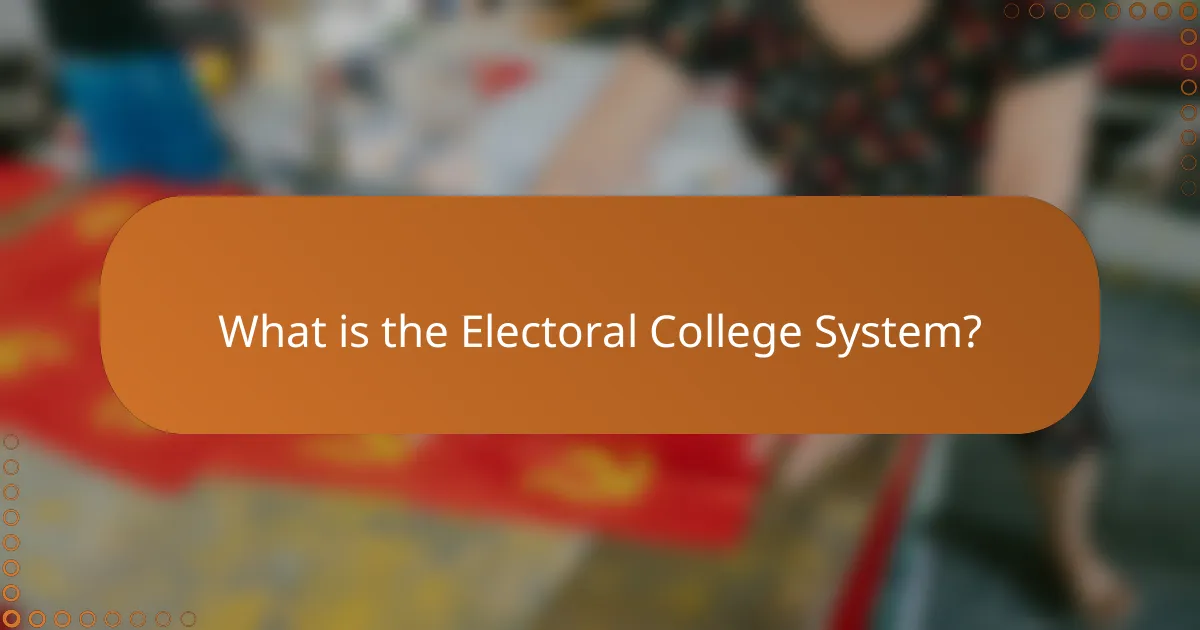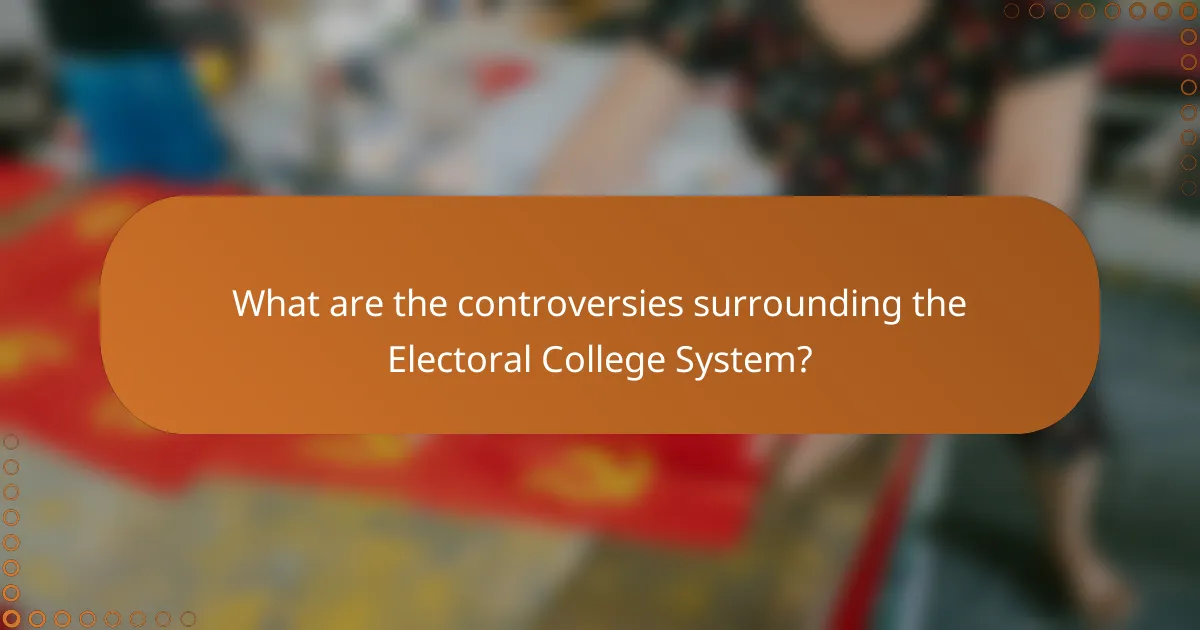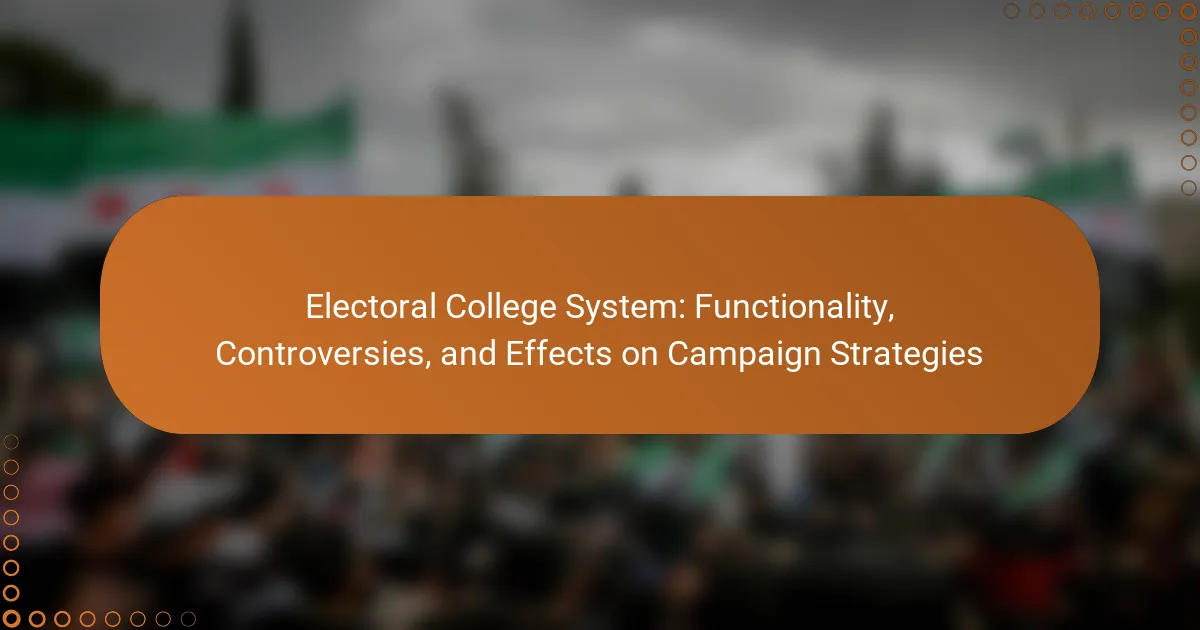The Electoral College System is a constitutional mechanism used in the United States for electing the president and vice president, comprising 538 electors with a majority of 270 votes needed to win. Each state’s number of electors is determined by its congressional representation, which includes both Senate and House members. This system has generated significant debate due to its potential to create disparities between the popular vote and electoral outcomes, exemplified in elections such as those in 2000 and 2016. Additionally, the Electoral College influences campaign strategies by directing candidate efforts toward swing states, often overshadowing issues pertinent to voters in states perceived as safe for one party. This article explores the functionality of the Electoral College, its controversies, and its impact on campaign strategies in U.S. presidential elections.

What is the Electoral College System?
The Electoral College System is a mechanism established by the United States Constitution for electing the president and vice president. It consists of 538 electors, with a majority of 270 votes required to win. Each state is allocated a number of electors based on its congressional representation, which includes both Senate and House members. The system was created to balance the influence of populous states with less populous ones. When citizens cast their votes in a presidential election, they are actually voting for a slate of electors pledged to a specific candidate. These electors then formally cast their votes for president in December following the election. The system has been the subject of debate, with critics arguing it can lead to a disparity between the popular vote and the electoral outcome. For example, in the 2000 and 2016 elections, candidates won the presidency without winning the popular vote.
How does the Electoral College System function in U.S. elections?
The Electoral College System functions by allocating a specific number of electors to each state based on its congressional representation. Each state has a total equal to its number of Senators (always 2) plus its number of Representatives in the House. There are a total of 538 electors in the Electoral College. To win the presidency, a candidate must receive a majority of the electoral votes, which is at least 270.
During the presidential election, voters in each state cast their ballots for their preferred candidate. The candidate who receives the majority of votes in that state typically receives all of its electoral votes, except in Maine and Nebraska, which use a proportional system. The electors then formally cast their votes for president and vice president in their respective state capitals in December.
The results of the Electoral College voting are then certified by Congress in January. This system was established by the U.S. Constitution and has been used since the first presidential election in 1789. The process aims to balance the influence of populous states with less populous ones in presidential elections.
What are the roles of electors in the Electoral College?
Electors in the Electoral College serve to formally elect the President and Vice President of the United States. Each state appoints electors based on its congressional representation. The total number of electors is 538, with a majority of 270 needed to win. Electors cast their votes in December following the presidential election. Their votes are then certified and sent to Congress. This process ensures that the election outcome reflects the will of the voters in each state. The role of electors is defined by the U.S. Constitution and various state laws.
How are electoral votes allocated among states?
Electoral votes are allocated among states based on their representation in Congress. Each state receives a number of electoral votes equal to its total number of Senators and Representatives. There are 100 Senators, two from each state, and 435 Representatives, distributed according to population. Additionally, the District of Columbia has three electoral votes despite not having congressional representation. This allocation is determined by the U.S. Census, which occurs every ten years. As a result, states may gain or lose electoral votes based on population changes. This system ensures that both population and geographical representation are considered in presidential elections.
What are the historical origins of the Electoral College System?
The Electoral College System originated from the Constitutional Convention of 1787. The framers of the Constitution sought a compromise between direct popular election and election by Congress. They aimed to balance the influence of populous states with less populous ones. The system allocates electors based on congressional representation. Each state has electors equal to its number of senators and representatives. This structure was influenced by concerns over direct democracy and the potential for mob rule. The first presidential election using the Electoral College occurred in 1789. George Washington was elected unanimously by the electors.
Why was the Electoral College established by the Founding Fathers?
The Electoral College was established by the Founding Fathers to balance the influence of populous states with less populous ones. This system was designed to ensure that all regions of the country had a voice in the presidential election process. The Founding Fathers feared that direct popular elections could lead to the dominance of larger states. They sought a compromise between electing the president by a vote in Congress and by popular vote. The Electoral College allocates electors based on state populations, which reflects both the number of representatives and senators each state has. This structure was outlined in Article II, Section 1 of the U.S. Constitution. The intention was to create a mechanism that would protect minority interests while still allowing for democratic participation.
How has the Electoral College evolved over time?
The Electoral College has evolved significantly since its inception in 1787. Initially, the founding fathers established it as a compromise between direct popular vote and congressional selection. Over time, the process of electing electors became more democratic. By the 1820s, most states began using popular votes to select electors. This shift aimed to increase public participation in the electoral process.
The 12th Amendment, ratified in 1804, refined the voting process for electors. It established separate ballots for President and Vice President. In the 20th century, the Electoral College faced criticism for its role in several elections. Notably, candidates such as Al Gore in 2000 and Donald Trump in 2016 won the presidency without winning the popular vote.
These instances sparked debates about potential reforms. Some proposed direct popular voting, while others suggested abolishing the Electoral College altogether. Despite these discussions, the system remains in place today. The Electoral College continues to shape campaign strategies, as candidates focus on swing states to secure electoral votes.

What are the controversies surrounding the Electoral College System?
The controversies surrounding the Electoral College System include its potential to misrepresent the popular vote. Critics argue that it can lead to a candidate winning the presidency without winning the majority of votes nationwide. This has occurred in U.S. elections, notably in 1824, 1876, 1888, 2000, and 2016. The system disproportionately favors smaller states due to the minimum of three electoral votes per state. This results in an unequal weight of votes, where individual votes in less populous states carry more influence. Additionally, the winner-takes-all approach in most states can marginalize third-party candidates. Supporters argue it protects minority interests and maintains federalism. However, the debate continues over its relevance in modern democracy.
Why do some people advocate for abolishing the Electoral College?
Some people advocate for abolishing the Electoral College because they believe it undermines the principle of one-person, one-vote. This system can result in a candidate winning the presidency without securing the popular vote. For instance, in the 2000 and 2016 elections, the candidates who lost the popular vote still took office due to Electoral College votes. Critics argue that this creates a disparity in voter influence across states. Smaller states receive disproportionate representation, leading to unequal campaigning efforts. Additionally, the winner-takes-all approach in most states can discourage voter turnout. These factors contribute to the call for reform or abolition of the Electoral College.
What are the main arguments against the Electoral College?
The main arguments against the Electoral College include its potential to distort the popular vote. Critics argue that a candidate can win the presidency without winning the majority of the popular votes. This has occurred in several elections, such as in 2000 and 2016. Additionally, the system gives disproportionate influence to smaller states. Each state’s electoral votes do not scale linearly with population, leading to an imbalance. Opponents also claim it discourages voter turnout. Many voters in states with a clear majority may feel their vote does not matter. Furthermore, the focus on swing states can lead to neglect of voters in solidly partisan states. This can skew campaign strategies and policy focus. These arguments highlight concerns about fairness and representation in the electoral process.
How does the Electoral College impact voter representation?
The Electoral College impacts voter representation by allocating electoral votes based on state populations. Each state receives a number of electoral votes equal to its total congressional representation. This system can lead to unequal weight for votes across states. For example, smaller states have a disproportionately higher number of electoral votes per capita. In the 2020 election, Wyoming had one electoral vote for about 195,000 residents, while California had one for approximately 718,000 residents. This disparity can result in situations where a candidate wins the presidency without winning the popular vote. In fact, this has occurred in five elections, including 2000 and 2016. Thus, the Electoral College can distort the principle of equal voter representation across the nation.
What criticisms have been raised about the fairness of the Electoral College?
Critics argue that the Electoral College is unfair because it can result in a candidate winning the presidency without the popular vote. This has happened in U.S. elections, notably in 1824, 1876, 1888, 2000, and 2016. The system disproportionately favors smaller states due to the minimum of three electoral votes per state. This means that votes in less populous states carry more weight than those in larger states. Additionally, the winner-takes-all approach in most states leads to disenfranchisement of voters who supported losing candidates. Critics also highlight that the focus on swing states neglects the interests of voters in non-competitive states. These factors contribute to perceptions of inequity in the electoral process.
How does the winner-takes-all approach affect election outcomes?
The winner-takes-all approach significantly influences election outcomes by awarding all electoral votes to the candidate with the most votes in a state. This system incentivizes candidates to focus on winning individual states rather than the national popular vote. Consequently, candidates prioritize campaigning in swing states, where the outcome is uncertain, often neglecting states with predictable outcomes. This can lead to unequal attention to voters across the country. For example, in the 2016 presidential election, Donald Trump won the presidency despite losing the national popular vote due to the distribution of electoral votes. The winner-takes-all system can thus amplify the impact of a few key states on the overall election result.
What are the implications of faithless electors?
Faithless electors can undermine the legitimacy of the Electoral College system. These electors do not vote for the candidate to whom they pledged. This action can lead to public distrust in the electoral process. It may also prompt legal challenges and calls for reform. In some states, laws exist to penalize faithless electors. However, these laws vary widely across the U.S. The 2020 election saw instances of faithless electors, raising concerns about their impact. Ultimately, faithless electors can disrupt the expected outcome of presidential elections.

How does the Electoral College System affect campaign strategies?
The Electoral College System significantly influences campaign strategies by directing candidates’ focus toward swing states. Candidates prioritize these states because they hold the key electoral votes needed for victory. For instance, in the 2020 election, both major party candidates concentrated their efforts on battleground states like Pennsylvania and Wisconsin. This strategy stems from the winner-takes-all approach in most states, where the candidate receiving the majority of votes secures all electoral votes. Consequently, candidates often allocate resources, time, and advertising to these crucial areas. This focus can lead to neglect of states perceived as safe for one party. Ultimately, this system shapes not only where candidates campaign but also the issues they prioritize based on regional interests.
What strategies do candidates use to win electoral votes?
Candidates use targeted campaigning to win electoral votes. They focus on swing states where the electoral outcome is uncertain. Building strong grassroots organizations in these states is crucial. Candidates also tailor their messages to resonate with local voters. Engaging in debates and town halls helps increase visibility. Fundraising efforts are concentrated in key states to maximize impact. Utilizing data analytics allows for strategic voter outreach. Historical trends show that winning swing states is essential for electoral success. For example, in 2020, Joe Biden focused heavily on Pennsylvania and Michigan, securing critical electoral votes.
How do candidates prioritize states in their campaigns?
Candidates prioritize states in their campaigns based on electoral value and demographic factors. They focus on swing states due to their potential to change election outcomes. States like Florida, Pennsylvania, and Wisconsin are often targeted because they have a significant number of electoral votes. Candidates analyze polling data and voter demographics to identify key issues in these states. They also consider historical voting patterns and campaign resources. For example, in the 2020 election, Biden and Trump invested heavily in battleground states. This strategy maximizes their chances of securing the necessary electoral votes to win the presidency.
What role does swing state targeting play in campaign strategies?
Swing state targeting is crucial in campaign strategies. Swing states are those where both major political parties have similar levels of support among voters. Campaigns focus their resources on these states to maximize electoral votes. For example, in the 2020 election, candidates invested heavily in states like Pennsylvania and Wisconsin. These states can determine the outcome of the election due to their electoral vote count. Targeting swing states allows for tailored messaging to undecided voters. This approach increases the chances of securing crucial electoral votes. Historical data shows that candidates winning swing states often win the presidency.
How does the Electoral College influence voter engagement?
The Electoral College influences voter engagement by creating a focus on swing states. Candidates prioritize campaigning in these states due to their potential to change election outcomes. This leads to increased voter turnout in swing states as residents feel their votes carry more weight. Conversely, voters in states with a strong party majority may feel disenfranchised. Research shows that high-stakes elections in battleground states can boost voter participation. For example, the 2020 election saw significant turnout in key states like Pennsylvania and Michigan, which were crucial for electoral votes. Overall, the system shapes where and how candidates engage with voters, impacting overall electoral participation.
What tactics do campaigns employ to mobilize voters in key states?
Campaigns employ various tactics to mobilize voters in key states. These tactics include targeted advertising, grassroots organizing, and voter outreach efforts. Targeted advertising focuses on specific demographics to convey tailored messages. Grassroots organizing involves building local networks to engage community members directly. Voter outreach efforts include door-to-door canvassing and phone banking to encourage voter turnout. Campaigns also utilize social media platforms to reach younger voters effectively. Data analytics play a crucial role in identifying and prioritizing key voter segments. Additionally, collaborations with local organizations help amplify their message. These strategies aim to increase voter participation in pivotal electoral regions.
How does the Electoral College affect voter turnout in non-swing states?
The Electoral College significantly affects voter turnout in non-swing states by discouraging participation. In non-swing states, voters often feel their votes carry less weight. This perception arises because these states are typically expected to vote for one party consistently. For instance, in states like California or Texas, the dominant party’s victory seems assured. Consequently, voters may believe their individual votes will not influence the outcome. Research indicates that voter turnout is typically lower in these states compared to swing states. For example, in the 2016 presidential election, voter turnout in non-swing states was about 60%, while swing states saw turnout rates closer to 70%. This disparity highlights the impact of the Electoral College on voter engagement in less competitive environments.
What are best practices for navigating the Electoral College System in campaigns?
To navigate the Electoral College System effectively in campaigns, candidates should focus on winning swing states. Swing states are crucial because they can be won by either major political party in elections. Candidates must allocate resources strategically to these states to maximize their electoral votes.
Building a strong ground game in these states is essential. This includes mobilizing volunteers and engaging local communities. Candidates should also tailor their messages to resonate with the specific issues affecting voters in these states.
Data-driven strategies can enhance campaign efforts. Utilizing voter analytics helps identify key demographics and voter preferences. Campaigns should also prioritize early voting and absentee ballot outreach to increase voter turnout.
Historically, candidates who invested time and resources in swing states have seen significant electoral gains. For example, in the 2000 election, George W. Bush focused heavily on Florida, securing a pivotal victory. This demonstrates the importance of targeted campaigning in the context of the Electoral College.
The Electoral College System is a constitutional mechanism for electing the President and Vice President of the United States, consisting of 538 electors, with 270 votes needed to win. This article examines the functionality of the Electoral College, detailing how electoral votes are allocated among states and the roles of electors. It also addresses the historical origins and controversies surrounding the system, including its impact on voter representation and campaign strategies. Additionally, the article discusses the implications of the winner-takes-all approach and the effects of faithless electors, while exploring arguments for and against the continued use of the Electoral College in modern elections.
